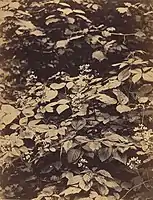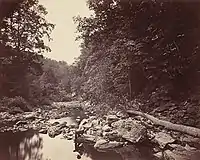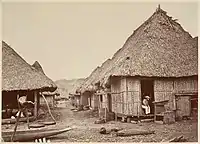John Moran | |
|---|---|
 Photograph and signature of John Moran | |
| Born | February 1831 Bolton le Moors, Lancashire, England |
| Died | February 19, 1902 (aged 70–71) |
| Occupation(s) | Photographer, artist |
John Moran (February 1831 – February 19, 1902) was a pioneering American photographer and artist. Moran was a prominent landscape, architectural, astronomical and expedition photographer whose career began in the Philadelphia, Pennsylvania area during the 1860s.
A brother of the painters Thomas, Edward and Peter Moran, Moran was a member of a network of Philadelphia-based artists, historians, and scientists who recognized photography as a fine art in the years before the American Civil War.[1]
Biography

John Moran was born during February 1831 at Bolton le Moors, Lancashire, England, the third of Mary (née Higson) and Thomas Moran's eight children.
At the age of 13, he arrived in Philadelphia, Pennsylvania on the passenger ship Thomas on May 31, 1844, having traveled with his mother and then six siblings.[2]
Moran was the one photographer among his accomplished siblings. Brothers Thomas, Edward and Peter trained as lithographers and became painters. Moran's sister Elizabeth married an artist and her two sons became painters.[3]
By the early 1890s, Moran resumed painting, joining his brothers Edward and Thomas in New York City where he wrote about art and exhibited his paintings.[4] A widower, living with his son Thomas Sidney Moran, he died there in 1902.
Moran's 1902 obituary in The New York Times mentioned Moran's role as "one of the pioneer photographers of this country".[5]
Advocate of photography as an artistic medium

In the 1850s, Moran was a pioneer in advancing photography as a medium of artistic expression. Moran said, "In photography, as in any work of art, the merit lies, in the power of seeing and deciding what shall be done...It is this knowledge, or art of seeing which gives value and importance to the works of certain photographers over others. There are hundreds who make, chemically, faultless photographs, but few make pictures..."[3]
Moran understood photography could achieve more than merely recording a moment, saying in 1865 "She (photography) can present imagery with a reality and force nearly rivaling the painter, and in some respects, superior."[3] “But it is the power of seeing and deciding what shall be done, on which will depend the value and importance of any work, whether canvas or negative.”[6]
Moran said "Art in all its forms is the form of thought, and the photographic work which rises to this plane is the expression of the ideas of the photographer. Nature... becomes plastic to his touch, and he moulds her to his judgment through (the photographer's) power to see the beautiful."[3]
Pioneer artistic photographer

Moran is listed in local Philadelphia directories as a lithographer in 1856, occasionally listing his profession as artist. He appears as a photographer from 1860 through 1885.
Moran was an early advocate of photography as art. His albumen silver print landscape photographs often appeared as frontispieces in Wilson's Philadelphia Photographer from 1864 to 1866.
Moran often created photographic images working alongside his brother Thomas as his brother painted the same subject view. Moran's photographs were images that balanced meticulous attention to detail with general atmospheric effects — techniques mirrored in his brother's paintings.[7] Moran often included a human subject in his images, providing the viewer an easily relatable sense of scale.
It is felt Moran was a humanistic, Arcadian photographer, employing his photographs of nature in a metaphorical way. The National Gallery of Art (US) said in 2016: "It is thought John Moran photographed "Wissahickon Creek near Philadelphia" (c. 1863) as an antidote to Civil War."[8][9]
Moran was mentioned often in the photographic press in America and Europe for both the aesthetic and technical quality of his photographs, and his theories on the medium.[9]
In addition to single photographic views, Moran also photographed many stereoscope photographs. Moran's images were printed on stereographic cards that were widely distributed and viewed using the newly developed stereograph.
Mower General Hospital
Moran created a photographic catalog of Mower General Hospital also known as Chestnut Hill Hospital for a series that he published for sale. Moran's photos were issued as both mounted photographs and stereographs soon after the facility was completed.[7]
The hospital, a major military facility, was built in 1862 on a lot of 27 acres, situated between Stenton, Germantown, Springfield and Abington avenues in Philadelphia's Chestnut Hill. Moran photographed a series of views of the hospital's innovatively-designed circular layout. Moran's exterior and interior views included photos of special medical wards that could be isolated for patients with infections and then novel centralized storage facilities for supplies.[10]
Pioneer scientific photographer

In addition to using photography as an artistic medium, Moran was recruited and hired as a photographer documenting scientific projects for the U.S. government.[9]
Isthmus of Panama Expedition of 1871
In 1871, Moran was hired as the official photographer during the second survey to the Isthmus of Darien in Panama, led by US Navy Commodore Thomas Oliver Selfridge Jr. to determine the best route for a canal across the isthmus.[3] Moran documented the trip with numerous still photographs, including many stereographs which were widely reproduced and sold throughout the world.
Transit of Venus photographic expedition of 1874

Four times during every 243 years, Venus passes between the Sun and Earth allowing its silhouette to be observed by skilled and amateur astronomers around the world. The transit of Venus occurs in pairs. The first of the pair that took place in the 1800s occurred on December 9, 1874.[11]
Moran served as chief photographer on the U.S. expedition to Australia, one of the eight American teams to join the 1874 international scientific effort to record the Transit of Venus across the sun, which would allow scientists to more accurately establish the distance between the Earth and the Sun. The effort helped unravel one of the primary mysteries of Solar System astronomy, the true value of the astronomical unit.
Moran sent back reports of his travels to the Philadelphia Photographer. Even though clouds and intermittent rain covered the sky at his station at Barrack Square in Hobart Town, Tasmania, Moran and his team in Australia brought back over 300 photographic documents, including 125 images of the Transit of Venus.[3][12][13]
The photographic equipment selected by the US expedition was the American Optical Company's "Venus Camera Box".[14] The unit used a special negative plate holder that allowed the photographer to take multiple exposures in register. Able to slide both vertically and horizontally, the holder employed pins that fit into a series of stepped registration holes. In order to create scientifically useful multiple exposures, the process required three photographers, one to expose the sensitized glass, one to move the glass, registering it with the pins and one to note the time of each successive exposure using a chronometer. Two sizes of plates were used. The large plates were exposed every 54 seconds. The smaller plates were exposed at a rate of 1.9 second intervals.[15]
Later career
In the late nineteenth century, the dry photographic plate was perfected. It replaced the wet collodion process Moran had used for years. He apparently lost interest in photography and resumed painting as a creative outlet.[4]
Artistic legacy
After 1865, the art of John Moran "disappeared" into collections of photographic prints and historic documents.[3] His seminal artistic photographs were "one-off" (individually hand printed and mounted) albumen prints and therefore limited in quantity. Original John Moran prints are over 150 years old and now quite rare.
Moran's photographs pre-dated rotogravure and halftone print reproduction, so his work was not able to be known by the public on a mass-market scale. Later photographers like Alfred Stieglitz greatly benefitted from having their work printed in magazines, art books and other publications. Consequently, photographers who followed Moran became better known to the public. Moran has been overlooked for decades.
Auction history
Moran's pioneering body of nineteenth-century early photography is being rediscovered, appreciated and collected. In 2010, Christie's New York auction house sold a Moran albumen silver print showing the demolition of the Bank of Pennsylvania. The sale price at $32,000 (equivalent to $42,943 in 2022), set a new auction record for an original John Moran print.[16]
Gallery
 Blackberry Bushes, 1862, albumen silver print, 19.4 × 15 cm (7 5/8 x 5 7/8 in.), collection of William L. Schaeffer
Blackberry Bushes, 1862, albumen silver print, 19.4 × 15 cm (7 5/8 x 5 7/8 in.), collection of William L. Schaeffer Broadhead’s Creek, Delaware Water Gap, 1863, albumen silver print, 26.3 × 33 cm (10 1/4 × 13 3/8 in.), National Gallery of Art, Washington, D.C.
Broadhead’s Creek, Delaware Water Gap, 1863, albumen silver print, 26.3 × 33 cm (10 1/4 × 13 3/8 in.), National Gallery of Art, Washington, D.C. Broadhead’s Creek, Delaware Water Gap, 1863, albumen silver print, 26.1 x 34 cm (10 3/8 × 13 in.) National Gallery of Art, Washington, D.C.
Broadhead’s Creek, Delaware Water Gap, 1863, albumen silver print, 26.1 x 34 cm (10 3/8 × 13 in.) National Gallery of Art, Washington, D.C. Limon Bay, High Tide., 1871, albumen silver print, 20.2 × 27 cm (7 15/16 × 10 5/8 in.), J. Paul Getty Museum, Los Angeles, California
Limon Bay, High Tide., 1871, albumen silver print, 20.2 × 27 cm (7 15/16 × 10 5/8 in.), J. Paul Getty Museum, Los Angeles, California Tropical Scenery, Street, Chipigana, 1871, albumen silver print, 20.3 x 27.9 cm (8 x 11 in.), The Metropolitan Museum of Art, New York, New York
Tropical Scenery, Street, Chipigana, 1871, albumen silver print, 20.3 x 27.9 cm (8 x 11 in.), The Metropolitan Museum of Art, New York, New York View near Chipigana., 1871, albumen silver print, 20.2 × 27.5 cm (7 7/8 × 10 13/16 in.), J. Paul Getty Museum, Los Angeles, California
View near Chipigana., 1871, albumen silver print, 20.2 × 27.5 cm (7 7/8 × 10 13/16 in.), J. Paul Getty Museum, Los Angeles, California Wilds of the Isthsmus., 1871, albumen silver print, 27.6 × 20.2 cm (10 7/8 × 7 15/16 in.), J. Paul Getty Museum, Los Angeles, California
Wilds of the Isthsmus., 1871, albumen silver print, 27.6 × 20.2 cm (10 7/8 × 7 15/16 in.), J. Paul Getty Museum, Los Angeles, California
Works
- Moran, John (1868). The Artists' Fund Annual: A Collection of Twenty Photographs From Original Designs By Members of the Artists' Fund Society of Philadelphia. Philadelphia, Pennsylvania: Artists' Fund Society of Philadelphia. – Illustrations are 20 mounted albumen photographs by John Moran of art works by E.B. Bensell, V. de V. Bonfield, John Faulkner, T.J. Fenimore, S.J. Ferris, James Hamilton, Ridgway Knight, G.C. Lambdin, Edward Moran, Peter Moran, Thomas Moran, W.T. Richards, Samuel Sartain, Christian Schussele, T. Henry Smith, N.H. Trotter, S.B. Waugh, W.H. Willcox, I.L. Williams, and G.B. Wood, Jr.
Essays
- Moran, John (March 1865). "The Relation of Photography to the Fine Arts". The Philadelphia Photographer.
- Moran, John (May 26, 1865). "The Relation of Photography to the Fine Arts". The Photographic News: A Weekly Record of the Progress of Photography. 9: 247. Retrieved June 22, 2020.
- Moran, John (June 1875). "Thoughts on Art, Nature and Photography". The Philadelphia Photographer: 179.
- Moran, John (October 1875). "Reflections on Art". The Philadelphia Photographer.
References
- ↑ "John Moran and Art Photography in America: 1855–1875". National Gallery of Art. United States of America. May 23, 2017. Retrieved September 24, 2020.
- ↑ "New York, Passenger Lists, 1820-1957". Retrieved June 22, 2020.
- 1 2 3 4 5 6 7 Panzer, Mary (2017), "John Moran (1831-1902), The First American Art Photographer", East of the Mississippi: Nineteenth-Century American Landscape Photography, Academia.edu
- 1 2 "Interesting Current Chat in the Camera Circles of the District of Columbia". Retrieved June 22, 2020.
- ↑ "John Moran Dead". The New York Times. February 20, 1902. p. 9. Retrieved June 20, 2020.
- ↑ Moran, John (March 1865). "The Relation of Photography to the Fine Arts". The Philadelphia Photographer: 3.
- 1 2 "East of the Mississippi: Nineteenth-Century American Landscape Photography October 6, 2017 – January 7, 2018". ininet.org. Retrieved September 24, 2020.
- ↑ "National Gallery of Art". June 21, 2016. Retrieved September 23, 2020.
- 1 2 3 Beckner, Sarah (August 1, 1990). More than a record: An analysis of the stylistic development in W. H. Jackson's Photography (MFA). Rochester Institute of Technology.
- ↑ "Mower U.S.A. General Hospital, Chestnut Hill, Philadelphia". The Library Company of Philadelphia. World Digital Library. Retrieved January 4, 2014.
- ↑ Russell, Henry Chamberlain. Transit of Venus 1874 - Observations of the Transit of Venus, 9 December 1874; Made at Stations in New South Wales. Sydney University Press. ISBN 9781920899905.
- ↑ Cottam, Stella (2015). Eclipses, Transits and Comets of the Nineteenth Century. Springer International Press. p. 225. ISBN 978-3-319-08340-7.
- ↑ "The Astronomer's Work". The New York Times. August 5, 1875. p. 3. Retrieved June 20, 2020.
- ↑ "The Expedition for the Observation of the Transit of Venus". The Photographic Times. Vol. 4. New York City, New York: Scovill Manufacturing Co. July 1874. Retrieved June 26, 2020.
- ↑ "The United States S.S. Swatara". The Argus. Melbourne, Victoria, Australia. February 20, 1875. p. 3. Retrieved June 20, 2020.
- ↑ "SALE 2395 Photographs at Christie's New York, October 6 - 7, 2010". Christie's. Retrieved September 23, 2020.